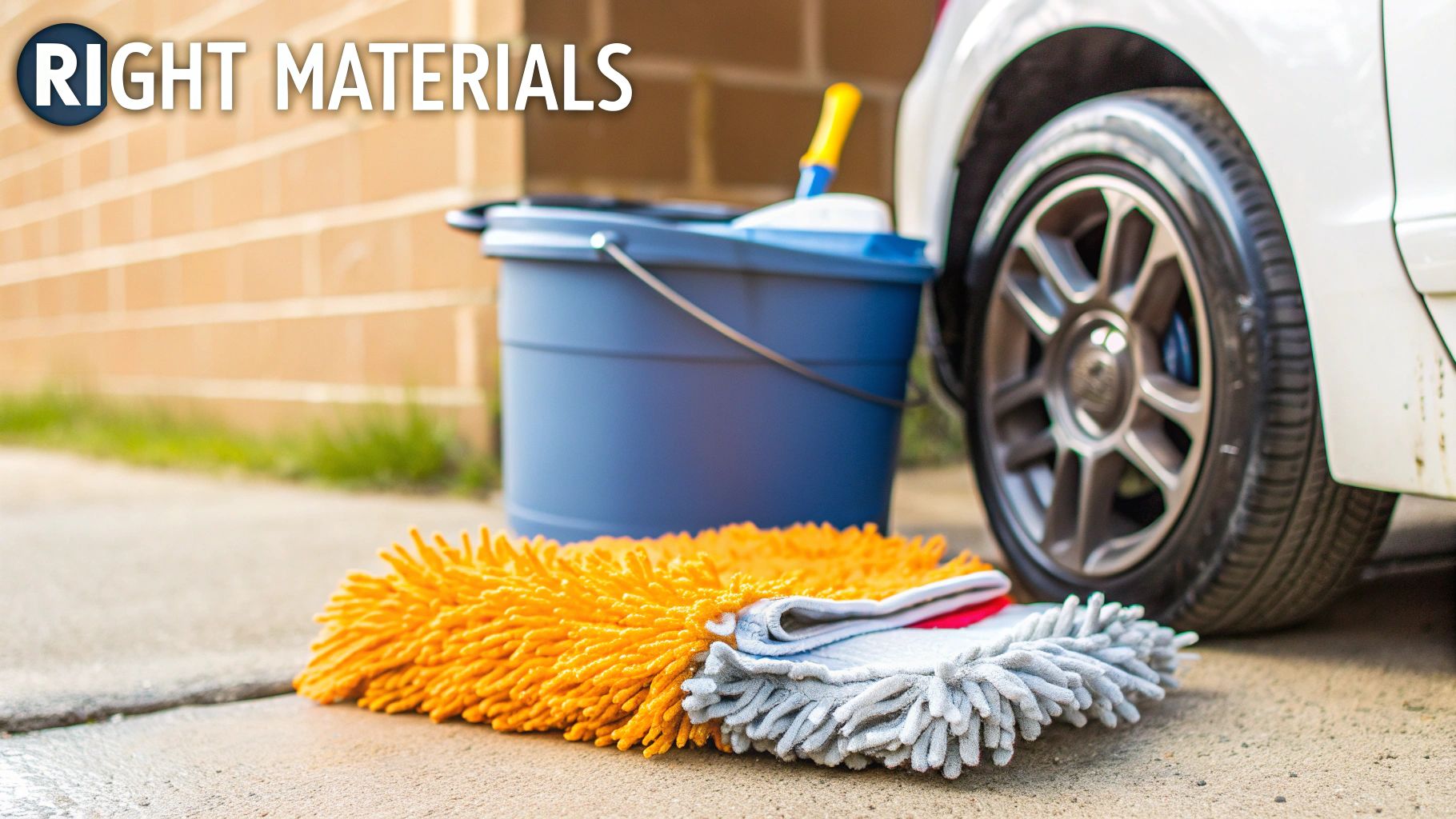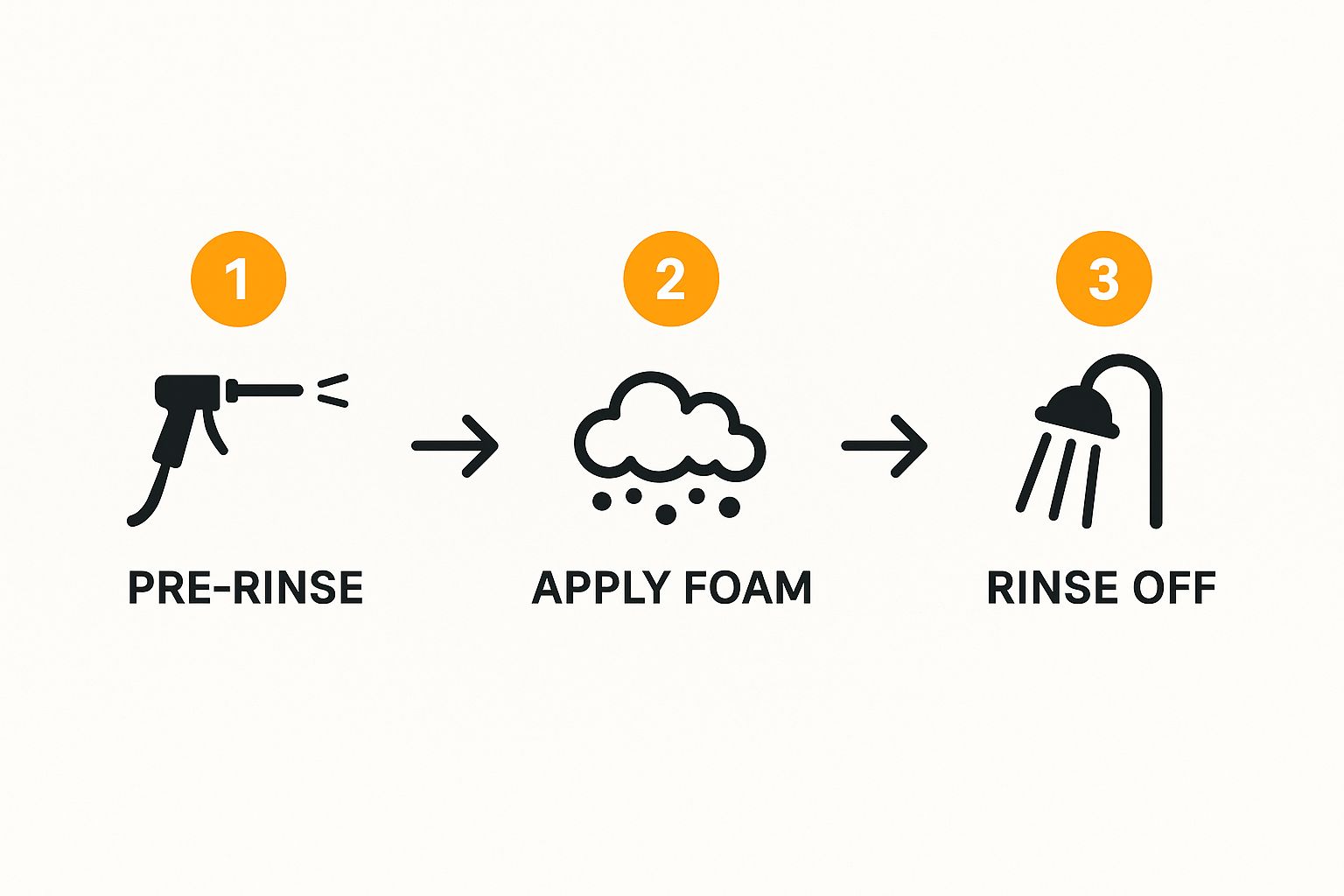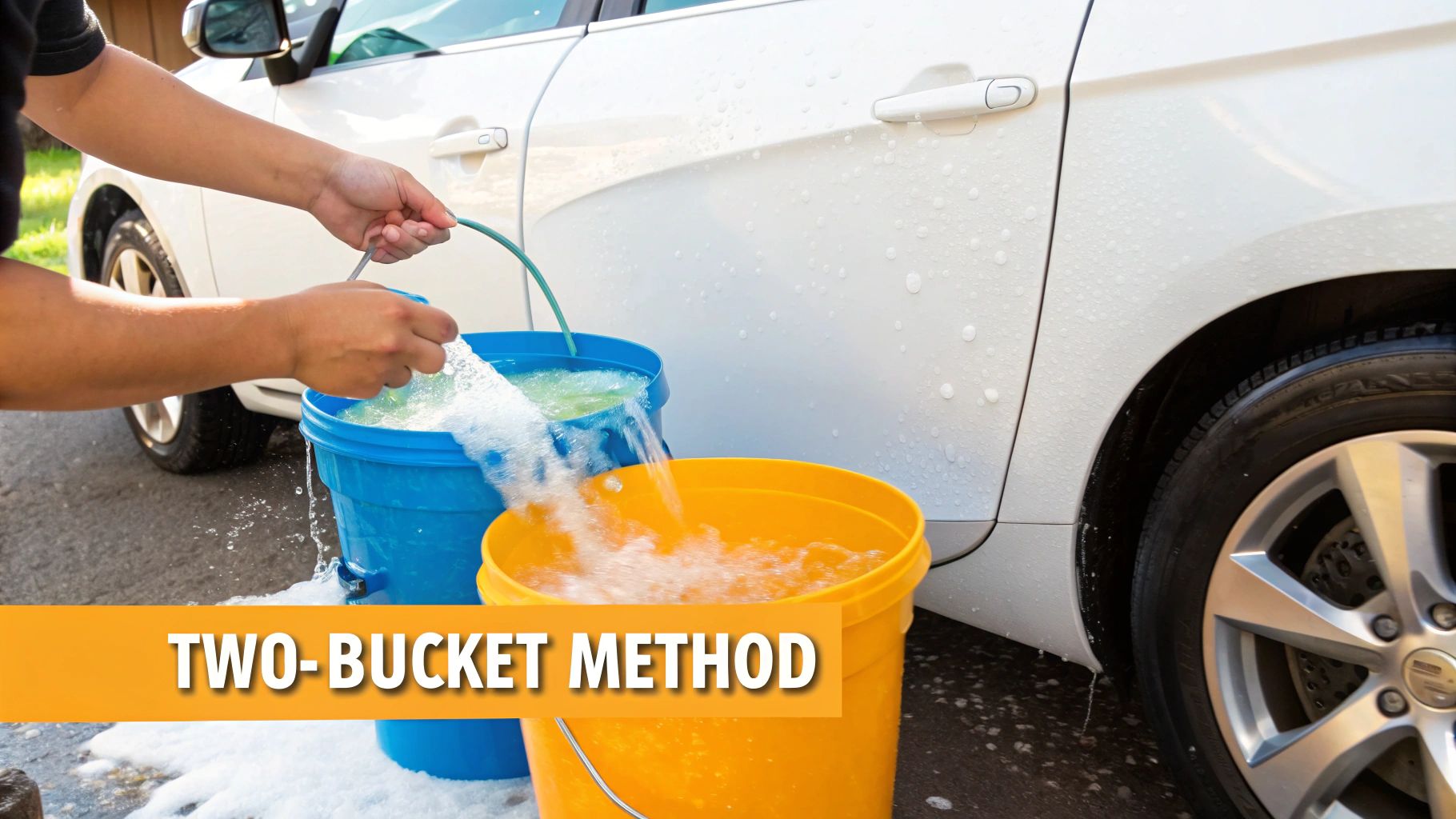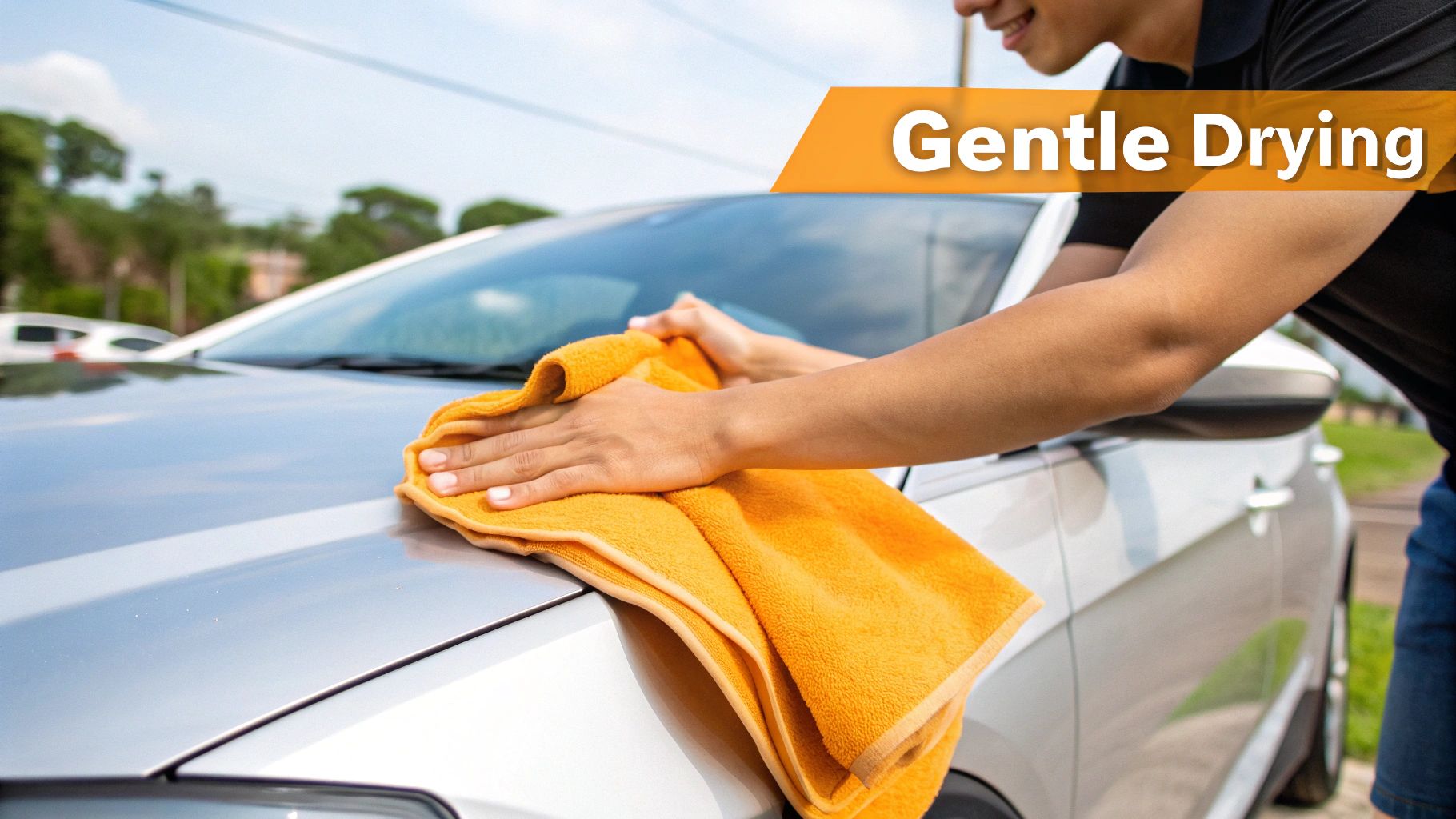The Science of Scratch Prevention: What's Really at Stake
Before we delve into the best car washing methods for a scratch-free finish, it's important to understand what we're up against: microscopic dirt and grime. These tiny particles, often invisible to the naked eye, become trapped between your wash mitt and your car's clear coat. Acting like sandpaper, they create swirl marks and micro-scratches that dull your car's shine. Understanding this is the first step towards effective scratch prevention.
Why Your Current Car Wash Might Be the Problem
Even a quick wash at a local gas station can be harmful. The brushes, often caked with abrasive dirt from countless previous washes, can inflict serious damage. The high-pressure spray, while seemingly effective, can actually force these dirt particles against your paint, worsening the problem. Convenience, in this case, often comes at the expense of your car's finish.
Studies show that automatic car washes, especially those with brushes, are a major contributor to paint damage. Data suggests that up to 30% of car owners report swirl marks or micro-scratches after using these types of washes. For more information, see Car Wash Myths Debunked.
The Impact of Environmental Factors
Beyond the washing process itself, environmental conditions also play a role. Direct sunlight can bake dirt onto your car's surface, making it more difficult to remove safely. Hard water can leave mineral deposits that etch into the clear coat over time. Choosing the right time and water source for your wash is therefore crucial. Learn more about protecting your car's paint in our guide: How to master car paint protection.
Understanding Your Car's Paint
Your car's paint is similar to human skin: it's composed of layers. The outermost layer, the clear coat, is the most delicate and vulnerable. Just like our skin, your car's paint requires proper care. Each wash is an opportunity to either protect or damage this sensitive layer. By understanding this, you can refine your car washing technique and maintain your car's pristine appearance. For advice on selecting the right tools, check out our article: Choosing the right car washer spray gun.
Building Your Scratch-Free Arsenal: Tools That Actually Work
Protecting your car's paint during a wash isn't just about technique; it's about using the right tools. That cheap wash mitt might seem like a bargain, but it could be harming your car’s finish. This section guides you through selecting truly paint-safe equipment for a brilliant shine without breaking the bank.
Choosing the Right Wash Mitt
The wash mitt is your primary point of contact with your car's paint. Opt for a high-quality microfiber wash mitt with a deep nap. This plush material traps dirt, preventing scratches. Think of it as a soft sponge versus a scouring pad: the gentler the material, the less likely it is to cause damage.
The Importance of Multiple Buckets
The two-bucket method is a cornerstone of scratch-free washing. One bucket holds your soapy water, the other, clean rinse water. This prevents re-contaminating your wash mitt with dirt, minimizing scratches. Learn more in our article about choosing the right car washer spray gun.
Drying Tools That Protect Your Paint
Drying is where many scratches occur. A high-quality microfiber drying towel is essential. Look for car-drying towels, as they're softer and more absorbent. Alternatively, a water blade removes most water, minimizing towel drying. Even without a garage, you can keep your car scratch-free. You might be interested in: How to protect your car without a garage.
Other Essential Tools
- Grit guards: Placed in your wash buckets, these trap dirt, preventing it from getting back on your wash mitt.
- pH-neutral car soap: Harsh chemicals can strip wax and damage the clear coat. A pH-neutral soap is gentler.
- Pre-wash spray: This loosens dirt before you touch the car, reducing scratch risk.

The following table summarizes essential car washing supplies for a scratch-free wash. It details the purpose, benefits, recommended features, and cost range of each item, making it easy to choose the right tools for your needs.
Essential Car Washing Supplies Comparison: A comprehensive comparison of necessary supplies for scratch-free car washing, including their benefits and recommended usage.
| Item | Purpose | Benefits | Recommended Features | Cost Range |
|---|---|---|---|---|
| Microfiber Wash Mitt | Washing car exterior | Gentle on paint, lifts and traps dirt | Deep nap, high quality microfiber | $5-$20 |
| Two Buckets | Wash and rinse system | Prevents cross-contamination | Durable, distinct colors | $10-$20 |
| Microfiber Drying Towel | Drying car exterior | Absorbent, minimizes scratching | Soft, plush, large size | $10-$30 |
| Water Blade | Drying car exterior | Quickly removes water | Silicone or rubber blade | $10-$25 |
| Grit Guard | Bucket insert | Traps dirt at bottom of bucket | Durable plastic, fits bucket securely | $5-$15 |
| pH-Neutral Car Soap | Washing car exterior | Gentle on paint, protects wax | Specifically formulated for cars | $10-$25 |
| Pre-wash Spray | Loosening dirt before contact wash | Reduces scratching, improves cleaning effectiveness | Safe for clear coat | $15-$30 |
As the table shows, investing in quality car wash supplies doesn't have to be expensive. Many effective tools are available at reasonable prices.
Maintaining Your Washing Arsenal
Even the best tools become scratch-inducing if not cared for. Wash microfiber mitts and towels after each use with a dedicated microfiber detergent. Avoid fabric softeners, which can clog fibers and reduce their effectiveness. Store your washing tools in a clean, dry place. This meticulous maintenance ensures your tools prevent scratches, not cause them. This approach to tool selection and maintenance sets the foundation for the best way to wash your car without scratching.
Mastering the Two-Bucket Method: Beyond the Basics
This isn't simply about using two buckets; it's about refining your entire car washing strategy. The two-bucket method offers the best way to wash your car without scratching it. We'll elevate this fundamental technique to a professional level. You'll learn the most effective way to section your vehicle, the specific washing motions that minimize contact with the paint, and how to maintain consistent soap lubrication.

This infographic highlights the crucial pre-wash rinsing steps: a high-pressure rinse, foam application, and a final rinse. This pre-wash routine significantly reduces the risk of scratching by removing loose dirt and debris before your wash mitt even touches the car.
The Core Principles of the Two-Bucket Wash
The two-bucket method is a widely recommended and highly effective way to wash a car without scratching the paint. It statistically reduces paint damage caused by dirt and grit. This method utilizes two buckets: one with soapy water and the other with clean rinse water. After washing a section of the car with a microfiber mitt soaked in soapy water, rinse the mitt in the clean water bucket. This removes dirt particles before dipping the mitt back into the soapy water. Learn more about the two bucket method.
The core principle is consistently rinsing your mitt after cleaning each section. This prevents the transfer of dirt back onto the car's surface. It's similar to washing dishes—you wouldn't wash a plate, then dip the dirty sponge back into the soapy water without rinsing it first.
Sectioning Your Car for Optimal Cleaning
Divide your car into manageable sections—roof, hood, sides, etc. This targeted approach allows you to focus on one area at a time, ensuring thorough cleaning and preventing dirt from drying before you can rinse it. This is especially important in direct sunlight.
For example, on a hot day, washing and rinsing small sections at a time prevents the soap from drying and potentially etching into the paint.
The Importance of Proper Washing Motions
Use straight, overlapping strokes when washing, avoiding circular motions. Circular washing can create swirl marks, particularly on darker colored cars. Light pressure is key. Let the wash mitt and soap do the work, not excessive force. Think of dusting a delicate object—gentle movements minimize the risk of damage.
Lubrication Is Your Paint's Best Friend
Maintaining sufficient soap lubrication is essential throughout the washing process. This slippery layer acts as a protective barrier, reducing friction between the mitt and the paint surface. Refresh your soapy water if it becomes dirty. This maintains optimal lubrication and dirt removal. Remember to use a pH-neutral car soap to protect your car's wax or sealant.
Adapting the Two-Bucket Method
The two-bucket method is adaptable. If you have limited space, smaller buckets will work. For stubborn contaminants, consider a pre-wash spray or a bug and tar remover before the two-bucket wash. These modifications maintain the method's core principles while addressing specific cleaning challenges.
Beyond the Basics: The Grit Guard
A grit guard, while not strictly part of the two-bucket method, is a valuable enhancement. Placed in the bottom of each bucket, the grit guard traps dirt and debris, preventing your wash mitt from picking it up. This further improves the two-bucket method's effectiveness in safeguarding your paint. These seemingly minor refinements are what elevate a casual car wash to a professional detailing, preserving your car's pristine finish wash after wash.
Pre-Wash Protocols: Where Paint Protection Really Begins

The most crucial steps in achieving a scratch-free car wash happen before you even think about touching the paint with a wash mitt. This is where a proper pre-wash comes into play. By adopting professional detailing techniques, you can drastically reduce the potential for scratches during the main wash. This section will guide you through the science-backed pre-wash protocols that truly make a difference.
The Power of the Pressure Washer
A pressure washer is your first line of defense against dirt and grime. However, using it correctly is key for the best way to wash a car without scratching. Start by using a wide fan spray and maintaining a safe distance from the car's surface.
This allows you to rinse off loose dirt and debris without the force of the water stream causing damage. Think of it like brushing off loose dust before wiping a delicate surface—it’s all about minimizing potential scratches from the get-go.
Foam Pre-Treatments: More Than Just Suds
Foam pre-treatments, also known as snow foams, aren't just for show. They play a vital role in encapsulating abrasive particles. These specialized foams are designed to cling to the car's surface, allowing the cleaning agents to work their magic.
The foam surrounds and lifts dirt particles away from the paint, making them easier to rinse off without causing scratches. This is particularly effective for removing road grime, bug splatter, and bird droppings, which can be extremely difficult to remove safely with a wash mitt alone.
Tackling Seasonal Challenges
Different seasons bring unique challenges. In winter, road salt can cling to your car, potentially causing corrosion. A pre-wash with a dedicated salt remover is crucial for preventing long-term damage.
During summer months, insect remains bake onto the paint. A pre-wash with an insect remover helps break down these proteins, making them easier to rinse away. For general road film and traffic grime, a traffic film remover (TFR) can be used sparingly to safely dissolve these stubborn contaminants.
These specialized pre-washes are essential for maintaining a scratch-free finish year-round. Let's explore some common pre-wash methods and their effectiveness:
To help illustrate the differences between various pre-wash techniques, the following table summarizes their effectiveness, time requirements, water usage, and ideal applications:
Pre-Wash Methods Effectiveness
| Pre-Wash Method | Dirt Removal Effectiveness | Time Required | Water Usage | Best For |
|---|---|---|---|---|
| Pressure Washer Rinse | Moderate | Low (5-10 minutes) | Moderate | Loose dirt and debris |
| Foam Pre-Wash | High | Moderate (10-15 minutes) | Moderate | Road grime, bug splatter, bird droppings |
| Salt Remover Pre-Wash | High (for salt) | Moderate (10-15 minutes) | Moderate | Winter road salt removal |
| Insect Remover Pre-Wash | High (for insects) | Moderate (10-15 minutes) | Moderate | Removing baked-on insect remains |
| Traffic Film Remover (TFR) | High (for road film) | Moderate (10-15 minutes) | Low to Moderate | Dissolving stubborn traffic grime |
As you can see, each method offers specific benefits depending on the type of dirt and grime you're dealing with. Choosing the right pre-wash for the situation is key to maximizing its effectiveness.
Seeing Is Believing
The effectiveness of a proper pre-wash is often best illustrated through side-by-side comparisons. A vehicle treated with a thorough pre-wash will show significantly fewer scratches and swirl marks after the main wash compared to a vehicle washed without a pre-wash.
This emphasizes the critical role of pre-washing in protecting your car's finish. This initial step dramatically reduces the risk of dragging abrasive particles across the paint during the subsequent hand wash, safeguarding your car's shine. For those interested in water-saving methods, consider checking out our guide on washing your car without a hose.
The Art of Proper Drying: Where Most Scratches Actually Happen
You've just finished washing your car, but the journey to a pristine, scratch-free finish isn't over yet. Surprisingly, the drying stage is often where unintentional damage occurs. Water, particularly hard water, leaves behind mineral deposits that can etch into your paint, creating water spots. Left untreated, these spots become difficult to remove and may require professional polishing.
Why Drying is a Critical Step
Just as you'd carefully clean a surface before applying a protective layer, like when learning how to clean wood cabinets, preparing your car for drying is crucial. Any remaining dirt becomes a scratching hazard if dragged across the paint during drying. This often happens with a poor-quality drying towel or improper technique. Improper drying also leads to those unsightly water spots, diminishing your car’s shine and potentially being mistaken for scratches.
Studies show approximately 40% of swirl marks and micro-scratches occur during the drying process, not the washing stage. This damage often results from using coarse or non-microfiber towels. Learn more about the impact of improper drying techniques here. This underscores the importance of the right tools and techniques.
Choosing the Right Drying Tools
A premium microfiber drying towel is a must-have for scratch-free drying. These towels are designed for quick, efficient water absorption, minimizing rubbing. Their soft texture is gentle on your paint, reducing scratch risk. Opt for a larger towel to dry more area with fewer passes, further minimizing potential damage.
Effective Drying Techniques
The Blotting Method: Gently blot the water from your car’s surface instead of rubbing. This prevents dragging dirt particles across the paint. Start at the top and work your way down, letting gravity assist you.
The Water Blade: A water blade, or squeegee, significantly speeds up drying time and minimizes towel contact. Glide the blade across the paint to remove excess water, leaving a thin film easily blotted dry with your microfiber towel.
Addressing Tricky Areas
Water tends to linger in areas like panel gaps, emblems, and grilles. A dedicated detailing microfiber towel or compressed air blower can dry these hard-to-reach spots, preventing water spots and streaks.
Proper Towel Management
Regularly flipping and folding your drying towel ensures a clean, dry surface is always touching your paint. This simple habit significantly reduces the risk of scratches. Wash your microfiber towels after each use with a microfiber detergent, avoiding fabric softeners, to maintain their effectiveness. Mastering these drying techniques, combined with proper washing, is the best way to maintain a spot-free shine and protect your car’s paint for years to come.
No-Touch Solutions: When Traditional Washing Isn't an Option

Sometimes, a traditional car wash just isn't feasible. Whether it's due to water restrictions, living in an apartment building, or simply a lack of time, there are alternatives. This section explores waterless and rinseless washing systems, helping you understand their real-world effectiveness.
Understanding Waterless Washing
Waterless car washes utilize a special high-lubricity spray designed to encapsulate dirt particles. This allows you to safely wipe away the dirt with a microfiber towel without scratching your car's paint. This method works best on vehicles that are only lightly soiled, similar to using a dust cloth on furniture. It’s great for dust, but not effective on heavy dirt or mud.
The Rinseless Wash Approach
Rinseless washing offers another alternative. It involves a specialized wash solution mixed with water in a bucket. Much like waterless washes, this solution encapsulates dirt, enabling you to safely wipe it off with microfiber towels. A key benefit of rinseless washing is its reduced water usage, making it a more environmentally friendly option. For a detailed guide on rinseless washing, check out our article on washing your car without a hose.
When No-Touch is Best (and When It's Not)
Both waterless and rinseless washes excel as maintenance washes between traditional washes. They’re also perfect for quickly cleaning bird droppings or bug splatters. However, if your car is heavily soiled, a traditional two-bucket wash remains the most effective way to achieve a scratch-free clean. Imagine trying to clean a mud-caked truck with only a spray and a towel – you'd likely grind the dirt into the paint, causing scratches.
Safe No-Touch Techniques
Even with no-touch methods, the right technique is essential. Always use high-quality microfiber towels. Work in small sections, frequently flipping your towel to a clean side. Wipe using straight, overlapping motions to avoid swirl marks. The goal, just like with traditional washing, is to lift the dirt away from the paint, not rub it in.
Evaluating Touchless Car Washes
Commercial touchless car washes provide a convenient option. However, they vary in quality. Some employ harsh chemicals that can strip wax and harm your clear coat. Others might not thoroughly remove dirt, leaving behind a residue that attracts more grime. Choose touchless washes that utilize pH-neutral detergents and offer protective coatings. This ensures a safe, effective clean that protects your car's finish.
Ready for a superior at-home car wash experience? The SwiftJet Car Wash Foam Gun makes car washing faster, easier, and safer. Its thick, clinging foam lifts dirt and grime, minimizing the risk of scratches. It also includes a free microfiber wash mitt and is backed by a 100% satisfaction guarantee. Visit SwiftJet today and discover the SwiftJet difference – the best way to wash your car without scratching.
